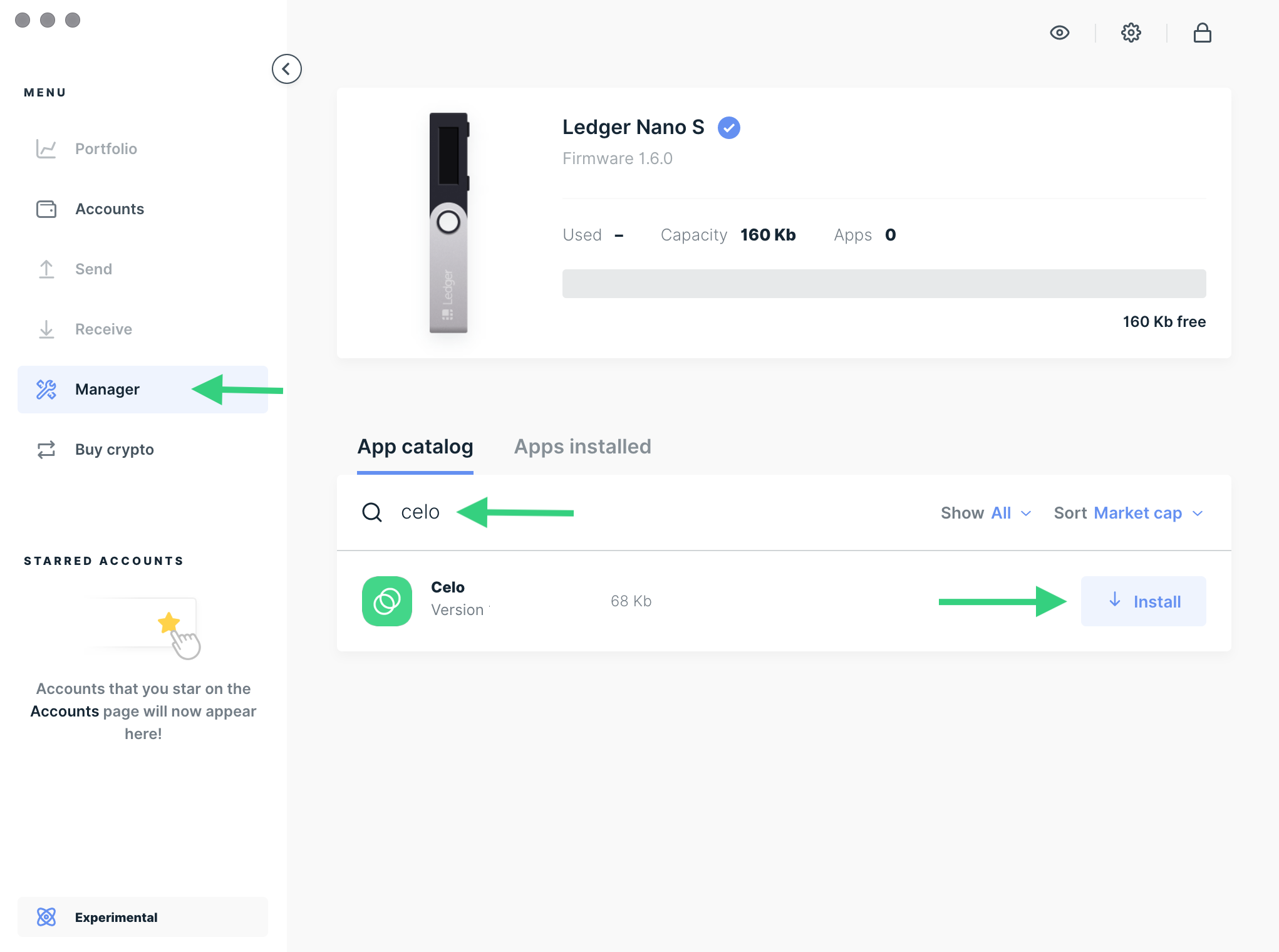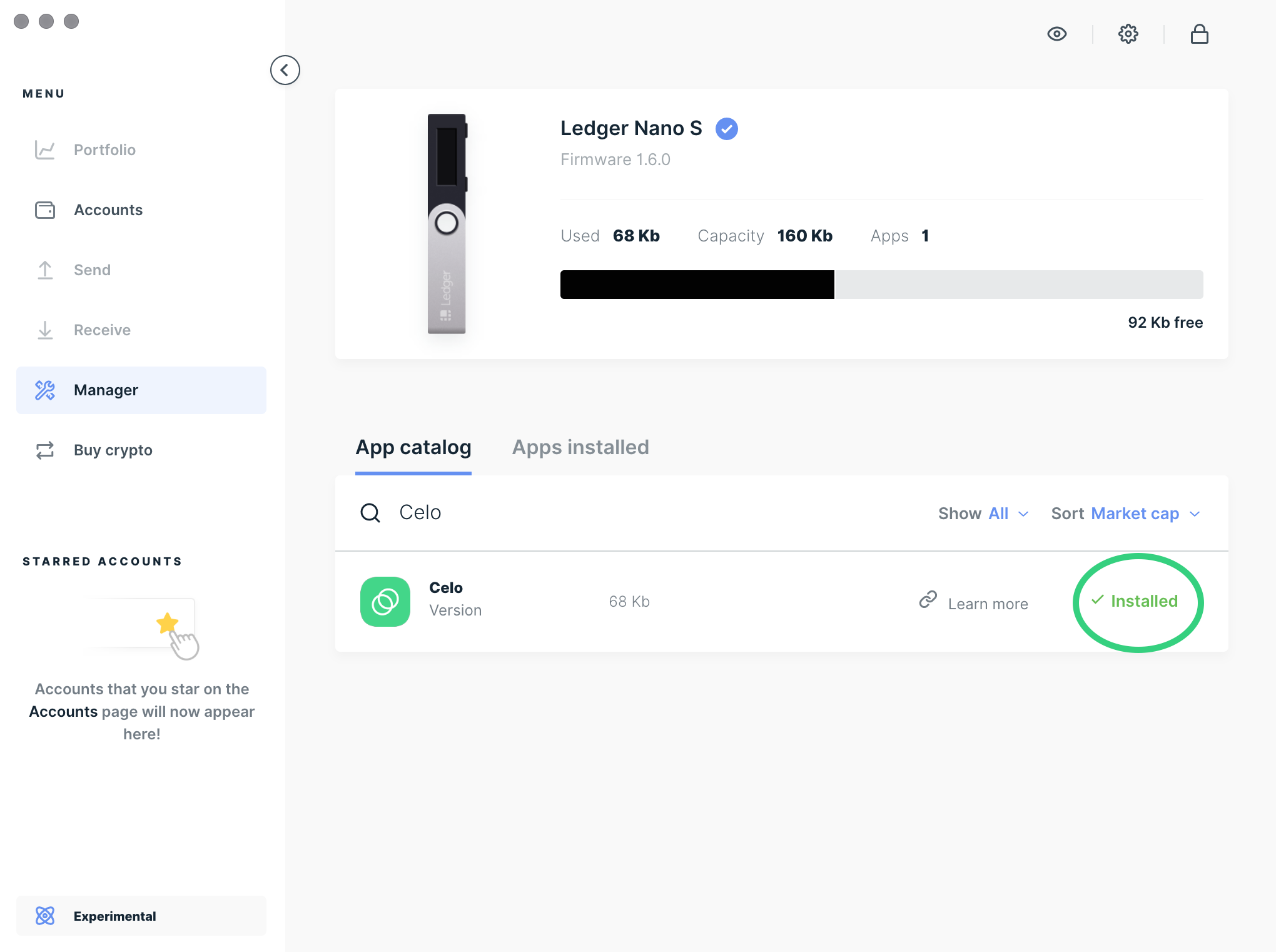This section shows how to set up a Ledger Nano S or X hardware wallet.
A hardware wallet or Hardware Security Module (HSM) holds a single random seed (expressed as a mnemonic) which can be used to generate any number of public-private keypairs, that is, any number of accounts ("wallets"), each with an associated address.
{% hint style="info" %} The steps below require technical knowledge. You should be comfortable with the Command Line Interface (CLI) and understand the basics of how cryptographic network accounts work. {% endhint %}
Make sure to have the following before you begin:
- Initialized your Ledger Nano X or S
- The latest firmware is installed
- Ledger Live is ready to be used.
- You have celocli installed.
Start by installing the Celo application and setting a PIN on your Ledger device by following steps 1 and 2 on this page.
{% hint style="danger" %} Make sure to securely back up both the PIN and the recovery phrase (also known as a backup key or mnemonic). If you lose them, or they are stolen, you lose access to your Celo assets with no recovery possible. The recovery phrase will be shown only once. {% endhint %}
Open the Ledger Live App on your computer and follow the instructions on the screen.
Search for “Celo” in the app store.
Click Install for the Celo app, this will install the Celo App Version 1.0.3 on your device.
{% hint style="info" %} If you’ve previously installed the Celo app on your device, you’ll see an Upgrade option instead of Install. {% endhint %}
The installation is completed once you see the green tick and Installed label.
You should now see on your device’s screen Celo app. You may need to toggle left or right using the buttons on the device to find the app.
Quit the Ledger Live app on your compute but keep the Ledger wallet connected to your computer.
On your Ledger Nano device enter the PIN if prompted and press both buttons at the same time to open into the Celo app.
Press both buttons on the device at the same time to continue.
The Celo app is now ready for use and you should see Application is ready on the screen.
Now that you have installed the Celo app on to your ledger, you can begin to use it with the Celo CLI.
Open the terminal application on your computer and install the Celo CLI:
npm install -g @celo/celocliIf you have previously installed the CLI, ensure that you are using version 0.0.47 or later:
celocli --versionAnd if not, upgrade by running the same command as above.
You will now need to point the Celo CLI to a node that is synchronized with one of Celo’s networks. We’ll be using the Alfajores Network.
Configure the Celo CLI so that it uses a cLabs node on the Alfajores network.
celocli config:set --node https://alfajores-forno.celo-testnet.org/{% hint style="danger" %} Connecting celocli to an untrusted node may allow that node to influence the transactions sent by the Celo CLI to the Ledger for signing. When in doubt, always use a node that you trust or are running yourself. {% endhint %}
Check that the node is synchronized:
celocli node:syncedThe output should display true. If it displays false you may need to wait a bit and try again.
The Ledger's current seed phrase determines the device's accounts. In the terminal on your computer, you can view the first account's address with the following command:
celocli account:list --useLedger --ledgerAddresses 1{% hint style="info" %}
If you wish to generate more than one address from your seed phrase, you can display the first N (e.g. 10) addresses use the --ledgerAddresses flag.
celocli account:list --useLedger --ledgerAddresses NTo display addresses at specific indexes Mand N(e. 2 and 654) use the --ledgerCustomAddresses "[M, N]"flag
celocli account:list --useLedger --ledgerCustomAddresses "[M, N]"{% endhint %}
{% hint style="info" %}
Advanced: Celo uses a BIP-32 derivation path of m/44'/52752'/0'/0/index, where index >= 0.
{% endhint %}
Before using your address on the Celo Mainnet, you may want to test it on the Celo Alfajores Testnet with the following instructions.
Visit the Alfajores Faucet and send yourself some testnet CELO at the following URL:
https://celo.org/developers/faucet
Check that you received the funds with the following command:
celocli account:balance <your-address> --node https://alfajores-forno.celo-testnet.org/Next, you'll need to enable "Contract Data" in the ledger app. Open the Celo App on your ledger device and go to Settings, then enable "Contract Data" to "Allowed". This setting is required because the celocli uses the ERC20 "pre-wrapped" version of CELO and so sending transactions requires sending data to a smart contract.
Perform a test transaction by running the following command:
celocli transfer:gold --from=<your-address> --to=0x0000000000000000000000000000000000000001 --value=10000 --useLedger --node https://alfajores-forno.celo-testnet.org/You'll need to then approve the transaction on the Ledger device. Toggle right on the device until you see Approve on screen. Press both buttons at the same time to confirm.
Finally, you can see if your transaction was mined on the network by copying the transaction hash (txHash) outputted by the command, and searching for it on the Alfajores Block Explorer.
You can use celocli to securely sign transactions or proof-of-possessions with your Ledger.
To use celocli with your Ledger, ensure the device is connected to your computer, unlocked, and the Celo app is open and displaying Application is ready.
Then, simply append the --useLedger flag to any celocli commands with which you'd like to use a Ledger. You may also append the --ledgerConfirmAddress flag, which will require that you manually verify on the Ledger the address from which the transaction is being sent.
In order to view your account Balance on your Ledger with celocli, you need to run the following command:
# If you haven't set the node config to mainnet, do it first
celocli config:set --node=https://forno.celo.org
celocli account:balance <your-address>This will display the specific account balance for your address on Celo Mainnet.
In order to receive Celo on your address, whether it's CELO or cUSD or any stablecoin in the future, you must share your specific address with the sender.
Once a sender has confirmed they sent you the assets to your Ledger address, ask for the transaction ID which you can lookup on the Explorer.
In order to send CELO or cUSD from your Ledger, you just need a recipient address to send to. Once you have that and the amount you would like to send (in our example, 10 CELO), we will go over how to send CELO using celocli.
celocli transfer:gold --from=<your-address> --to=<recipient-address> --value=10 --useLedgerYou'll need to then approve the transaction on the Ledger device. Toggle right on the device until you see Approve on screen. Press both buttons at the same time to confirm.
You'll then get a transaction hash when it's confirmed that the transaction was mined by the network, and you can check the status of the transaction on the explorer here.
If you have issues connecting to the Ledger, try the following:
- Check that the Ledger device is connected, powered on, and that you've unlocked it using the PIN.
- Check that no other applications are using the device. Close Ledger Live. Stop any local Celo Blockchain node, or ensure it is run with the
--nousboption. - Try unplugging and replugging the device. Some devices appear to trigger a warning on Macs saying: “USB Devices Disabled. Unplug the device using too much power to re-enable USB devices” which is usually resolved by reconnecting.
- Ensure that you are using the original cable supplied with your Ledger.
- Ensure that your Ledger has the latest firmware. For Ledger Nano S, a firmware version of 1.6 or later is required.
- Ensure that you are running the latest version of the Celo CLI.
There have been reports of a possible issue that appears to affect developer store apps on the Ledger Nano X including the Celo Ledger App. This is believed to be fixed in version 1.0.3. In earlier versions, a user clicking through the Pending Ledger review notice too rapidly can cause the device to freeze. If this occurs, wait until the device's battery is depleted, then charge and power up again. Then use Ledger Live Manager to update the installed version of the Celo Ledger App.
An alternative to using celocli is celowallet.app which supports Ledger and provides a simple interface for transacting with Celo accounts.
- Load the wallet app in a modern browser, Chrome is recommended.
- Click on
Use Existing Accountoption. - Click on the Ledger icon.
- Connect your Ledger Nano to your computer.
- Unlock your Ledger Nano with your PIN.
- Go to the Celo app on your Ledger Nano and open it.
- On
celowallet.appwebsite, click onImport Account. Make sure you are using the right Address Index. Index 0 means the first address on the list. - There will be a popup in the web browser to approve the Ledger device, click on Nano in the popup and click
Connect. - Verify on your Ledger Nano that this is the address you want to use, then click the right button on the Ledger until you see
Approvethen click both buttons to approve. - You are now using celowallet.app with your Ledger

